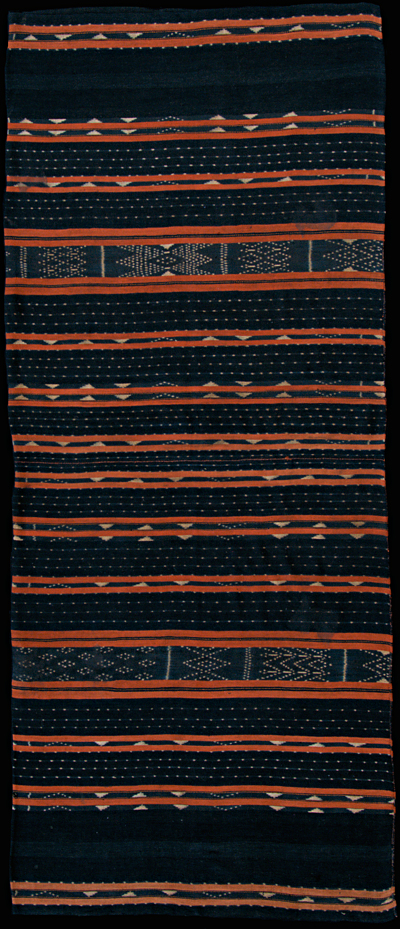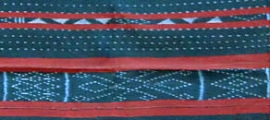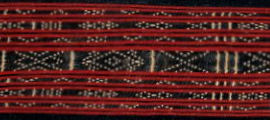| |
 
 | | | |
305 Flores Group, Palu'e
Tama (sarong)  
| | Locale: | Kéli domain, or allied Ndéo | | Period: | 19th to early 20th c. | | Yarn: | Unusual combination of hand-spun and machine made yarn. See microscopic observations. | | Technique: | Warp ikat | | Panels: | 2 | | Size: | 60 x 170 cm (1' 11" x 5' 6") LW: 2.83 | | Weight: | 580 g (20.5 oz), 284 g/m2 (0.93 oz/ft2) | | Design: | Type of tama (or dhama) called wua wéla ‘dehiscing areca’ (stage in the flowering of the palm). An archetypical example of Palu'e sarongs, the design of which has remained constant over the last century, both in terms of the banded structure, the type of motifs, some of them patola-inspired, and the characteristic drawing technique by means of stippling. The motifs seen in the top ‘mother’ band are called (left to right): 1. manu wa'ine (chicken feet, quadruple form); 2. séra lapene (‘Ceram in layers’); 3. manu wa'ine (chicken feet, quadruple form) 4. mata kéo (maize eyes). Bottom mother band: 1. laku la’éne (traces of civet cat); 2. manu wa'ine (chicken feet); 3. woka wingane (arrows with barbs); 4. mata kéo (maize eyes). The word séra is associated with the seafaring peoples of the region, especially the Bugis. The pattern hua wuane, the horizontal lines of ikat dots, takes its name from a vine tuber with tiny white-yellow fruits. The vine plant, how its parts are linked to a whole, becomes a metaphor for the mutually helpful society.�(Names of motifs provided by Stefan Danerek.) The largest motif (see image below and additional information) is easily recognized as an angular rendering of patola jilamprang motifs, very similar to the main motifs on PC 209. The fine curcuma dyed pinstripes that separate some of the red bands symbolize, according to Vischer’s sources, the placenta - the female element in marital bonds and more broadly affinal relations. The white triangles, called nua, represent houses or mountains. See reverse side and additional information. | | Comment: | As Vischer remarks in his contribution to Hamilton's Gift of the Cotton Maiden, Palu'e cloths collected around 1900 [and others datable to the same period such as this example] show a remarkable continuity with those produced at present - though the use of natural dyes has practically disappeared. As morinda is not grown on this dry island, the red dyes used here (as on all or nearly all Palu'e sarongs from the period), is probably chemical; the yellow curcuma. Assuming that PC 209 is indeed an early Palu'e tama, a few stylistic changes were made in the last quarter of the 19th c., including the switch from Perkin's violet to red for the stripes that separate the ikated areas, and the rendering of the triangular nua - from stippling outlines to filled in. The indigo, venerated by the Paluans, is deeply saturated, almost black. The solid bands at the extremities both contain a circa one inch band with somewhat less dense, almost gauze-like weaving. | | Background: | Chapters on Flores Group and Palu'e. | | Published: | Ikat from Timor and its Outer Islands, 2022.
| | Compare: | 209 | | Sources: | Similar to tama depicted in Vischer's contribution to Hamilton, ed., Gift of the Cotton Maiden, Fig. 12-14. Also see photo of Palue dancers wearing tama, same work, Fig. 12-10. Details similar to those on Fig. 12-18. The main motifs, an angular version of jilamprang drawn in stippled lines, are very similar to those on presumed Palu'e tama PC 209 and to 1970s Palu'e sarong in Barnes and Hunt Kahlenberg, Five Centuries of Indonesian Textiles, Plate 82 and to a 1950s Palu'e sarong sold at Klefisch auction 95. See detail below.

Design also very similar to mid 20th C. tama in National Gallery of Australia, Nr. 86.1921, depicted below. Information on motifs provided by Stefan Danerek.

| | |

©Peter ten Hoopen, 2024
All rights reserved.
|
|


